The Intel SSD 540s (480GB) Review
by Billy Tallis on June 23, 2016 9:00 AM ESTATTO
ATTO's Disk Benchmark is a quick and easy freeware tool to measure drive performance across various transfer sizes.
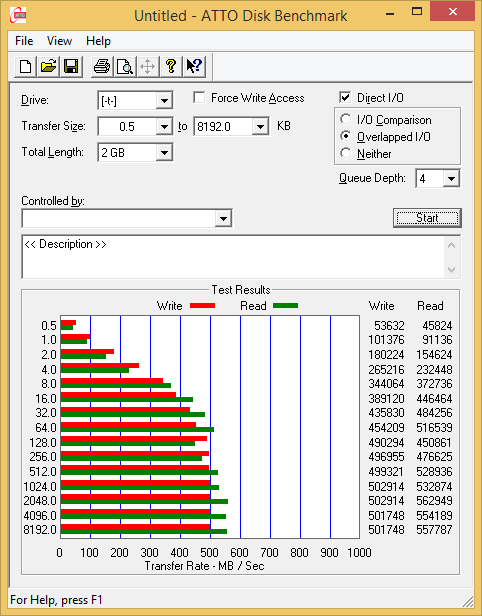 |
|||||||||
The Intel 540s's performance is a bit uneven during the ATTO benchmark, but its write speed advantage over the SP550 is still quite clear.
AS-SSD
AS-SSD is another quick and free benchmark tool. It uses incompressible data for all of its tests, making it an easy way to keep an eye on which drives are relying on transparent data compression. The short duration of the test makes it a decent indicator of peak drive performance.
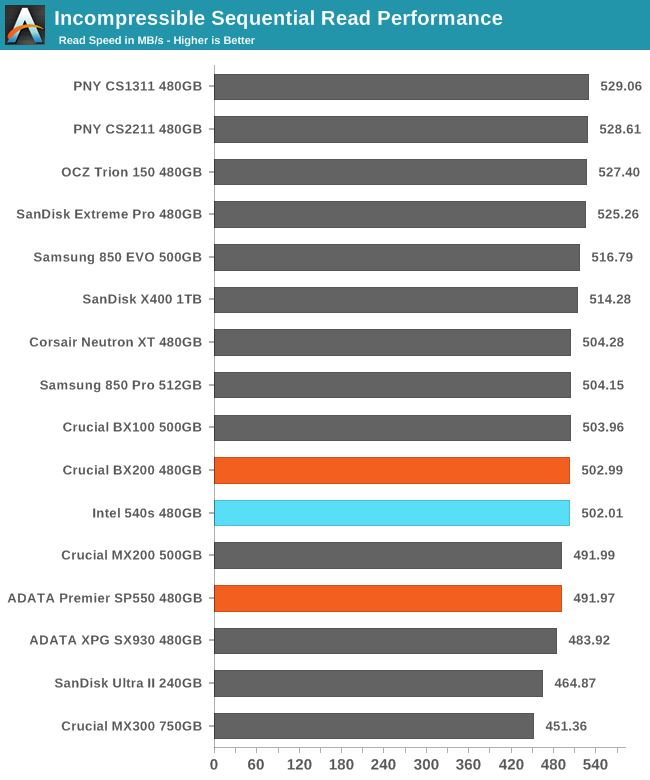
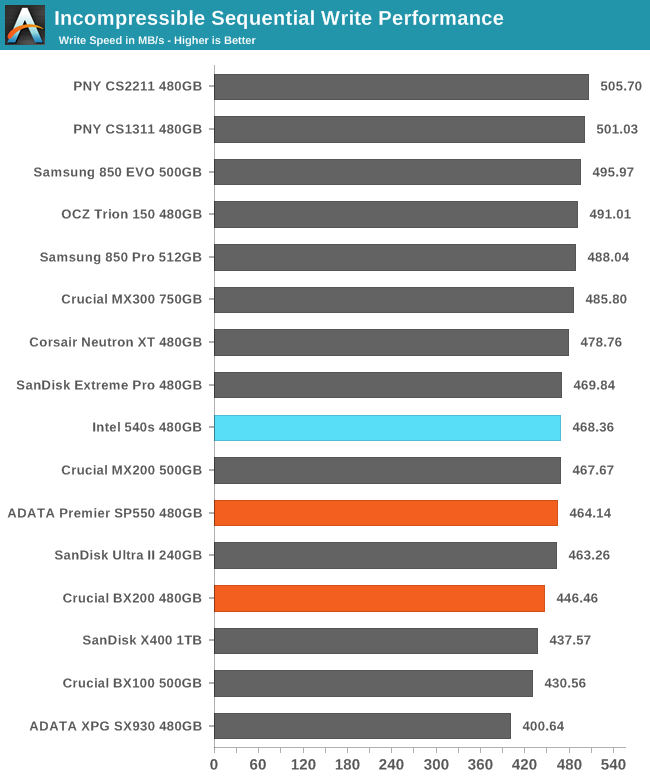
The AS-SSD test does very little to differentiate between drives, but it at least shows that the Intel 540s can reach similar peak speeds to its competition.
Idle Power Consumption
Since the ATSB tests based on real-world usage cut idle times short to 25ms, their power consumption scores paint an inaccurate picture of the relative suitability of drives for mobile use. During real-world client use, a solid state drive will spend far more time idle than actively processing commands. Our testbed doesn't support the deepest DevSlp power saving mode that SATA drives can implement, but we can measure the power usage in the intermediate slumber state where both the host and device ends of the SATA link enter a low-power state and the drive is free to engage its internal power savings measures.
We also report the drive's idle power consumption while the SATA link is active and not in any power saving state. Drives are required to be able to wake from the slumber state in under 10 milliseconds, but that still leaves plenty of room for them to add latency to a burst of I/O. Because of this, many desktops default to either not using SATA Aggressive Link Power Management (ALPM) at all or to only enable it partially without making use of the device-initiated power management (DIPM) capability. Additionally, SATA Hot-Swap is incompatible with the use of DIPM, so our SSD testbed usually has DIPM turned off during performance testing.
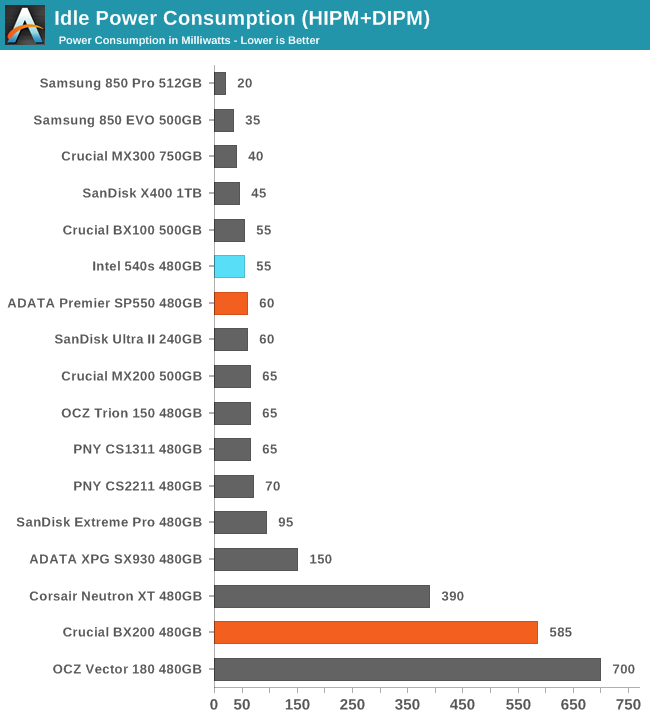
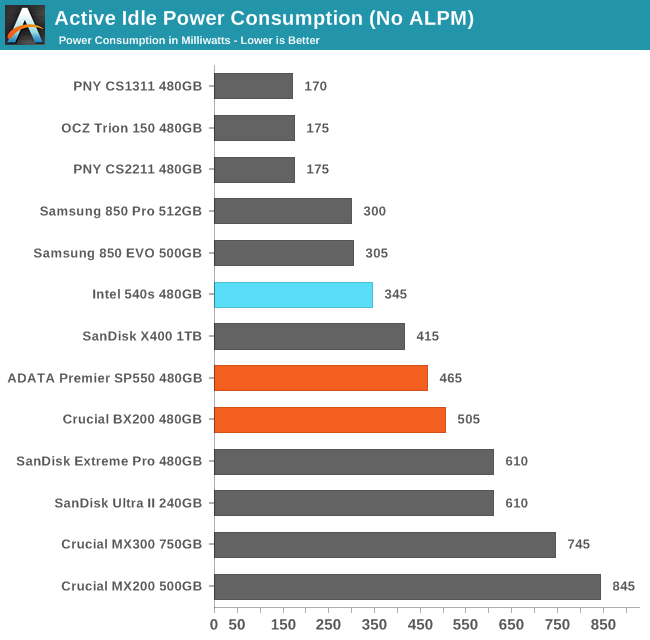
The slumber power state is working correctly on the Intel 540s and allows for very slightly lower idle power draw than the SP550. Active idle power is significantly improved over the SM2256 and is now behind only Samsung and Phison controllers. Silicon Motion's 40nm SM2258 clearly beats Marvell's 28nm 88SS1074 used in the SanDisk X400 and Crucial MX300.










77 Comments
View All Comments
doggface - Thursday, June 23, 2016 - link
I am ... Amazed that Intel would dirty their brand name like this. Truly a terrible controller, terrible flash, and a terrible idea.Intel has a brand name that generally speaks to quality parts. They should never have dabbled in the arena of TLC.
ddriver - Thursday, June 23, 2016 - link
Reveals optane, releases mediocrity... come on.Drumsticks - Thursday, June 23, 2016 - link
I actually worked on this for a short time last year, and I can say - working with SMI definitely is not as easy (at least for Intel) and was certainly more frustrating than developing in house.BurntMyBacon - Friday, June 24, 2016 - link
Any reason they didn't label a drive with this level of performance a 300 series drive?Drumsticks - Friday, June 24, 2016 - link
No idea, honestly. I think everything is just a 5xx SSD now (at least the SATA stuff). I think it's priced well above what I was expecting it to be priced at though, tbh.pwil - Wednesday, July 27, 2016 - link
300 series had 3y warranty.JoeyJoJo123 - Thursday, June 23, 2016 - link
HERE COMES THE SSD MEMES!>Muh MLC!
>Muh endurance!
>Muh data retention!
>Muh reliability!
>Muh random I/O!
>Muh this drive isn't exactly what I want in my PC, so instead of using PC Part Picker to find a suitable drive for my incredibly critical tastes, I'm going to post a comment on a news article expressing how disgusted I am by how this drive isn't up to _MY_ standards.
FUN FACT: Did you know that companies design products for people besides yourself?
b4bblefish - Thursday, June 23, 2016 - link
Meh... it's not that they make products for people besides us. It's that for the price it's a horrible deal. You can buy better more reliable drives for a lot cheaper especially if it's targeting the entry level consumer market. So why bother entering this segment and offer something without any value?JoeyJoJo123 - Thursday, June 23, 2016 - link
Because these drives are likely aimed at bulk government/corporate purchases, not really for consumers as the price/performance ratio is terrible. Government/corporate entities will end up buying bulk, even when the price isn't the best available, from what the business analysts approve as reputable companies; not because it's a wise purchase from an IT perspective.I guarantee you this: It's got an Intel sticker, so it'll be bought in droves by people who don't know, even if it sucks. See: Pentium 4.
And secondly, nobody should ever care for brand image. Every brand releases crap products from time to time. Some brands do this more often than others. Always evaluate products on an individual level, not because they happen to come from some "reputable" brand.
techconc - Thursday, June 23, 2016 - link
I agree with most of your post. However, you went off the rails with regard to brand image. Yes, you shouldn't buy based on brand image alone. However, all things being equal, brand reputation does come into play. Companies earn a reputation, for better or worse, based on the quality of the product they produce. Completely disregarding that history isn't very good advice.